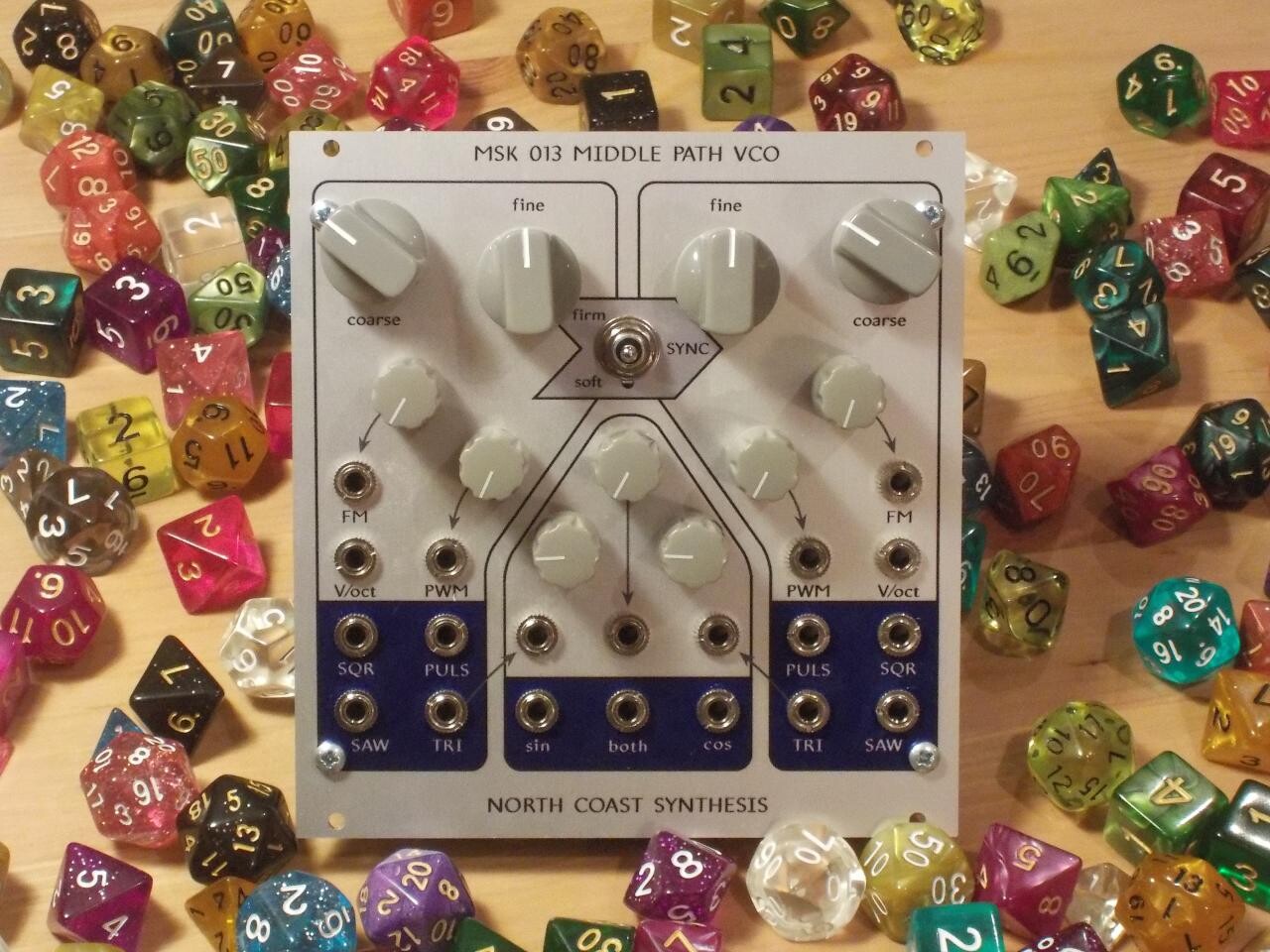Middle Path sample patches
2020-06-02 MSK 013
I'm preparing for the release of the Middle Path VCO. That should be announced in the email newsletter within a few days. There will be only a few modules available in the first wave so I'm probably not going to do the big public announcement until a few weeks later when I've got more supply; other things going on in the world at this time have created some supply-chain problems for me and that's also one reason I haven't written much new content in this Web log for a while. I'd really like to be able to sell out the first batch of Middle Paths on just the newsletter announcement so that I can use the cash to get more parts for further production. Anyway, one of the last steps in the release process is to write up sample patches for the manual, and I figured those would also make a good Web log entry.
The simplest way to patch the Middle Path is to not really patch it at all. Just running it by itself with no input except the front-panel controls, it can produce a variety of different spectra for drones and background pads. Taking output from the "sin" and "cos" outputs of the sine shaper gives a fake stereo effect. Note that the V/octave inputs normalize to the Eurorack CV bus when there are no cables plugged into the front panel, so even without plugging in an input cable, the module can take pitch control from somewhere else if used with modules like the Doepfer A-185-1 that can send a control voltage to the bus.
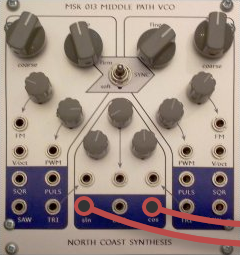
Here are two independent subtractive East Coast-style voices in an 84HP Eurorack row, using the Middle Path as a dual general-purpose VCO. Pitch CV from the MIDI interface drives the two V/oct inputs of the Middle Path, as well as the pitch CV inputs of the filters, which in this case are Coiler VCFs. Gate CV drives two ADSR envelope generators for each voice, which control the filters and VCAs.

A more full-featured subtractive patch can use both oscillators of the Middle Path in a single voice, as well as showcasing a couple of other North Coast modules. Pitch CV goes through a Dual Octave Switch, which allows for easily shifting either oscillator up or down during performance. The Fixed Sine Bank provides PWM to one oscillator and FM to the other. The PWM on the first oscillator won't be audible in its triangle output, which is the default normalized to the sine shaper, but using firm sync mode would allow the PWM to have an effect, or we can patch the PULS output into one of the sine shaper's inputs as shown. The MIDI gate drives two ADSR envelopes, one for the filter and one for the VCA. The Doepfer VCA used here has two audio inputs so we patch in the low-pass and band-pass outputs of the filter to provide some mixing options.
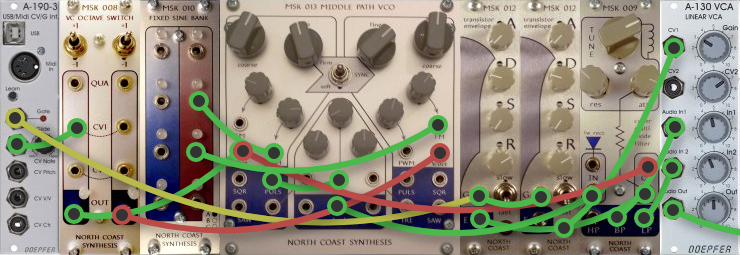
The sine shaper can process an external input if it's raised to an appropriate level. Depending on how hard it's driven, it can range from just a mild enhancement of odd harmonics, through tube-like foldback, into complete wavefolding. In this example, the three outputs from the shaper go through a Transistor Mixer to mix them down and provide some additional distortion options of its own. Turning down the levels on the Transistor Mixer allows it to knock the level back down to a typical audio "line level" for further connection to non-Eurorack equipment.
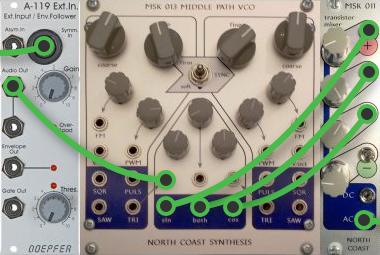
Here's a West Coast-style voice emphasizing the modulation effect of the Middle Path sine shaper, with a Leapfrog VCF serving as a low-pass gate. With the pitch CV patched into the left oscillator as shown, it will affect both, so the carrier and modulator will track each other. Another possibility would be to patch it in on the right instead; then it will only affect that oscillator while the other one remains at an unchanging frequency set by the front-panel controls or the Eurorack bus CV.
Through-zero phase modulation is achieved when the slope of the modulator waveform exceeds that of the carrier, so that the phase input to the sine shaper runs backwards. Tune one oscillator to a higher frequency than the other, and adjust the lower-frequency oscillator to a higher input level on the sine shaper, to get through-zero with this patch. The envelope can drive just the filter cutoff for a pure low-pass gate effect, or patch it into the Leapfrog's built-in VCA also for a more extreme cutoff of amplitude as well as frequency (which allows tuning the filter higher).
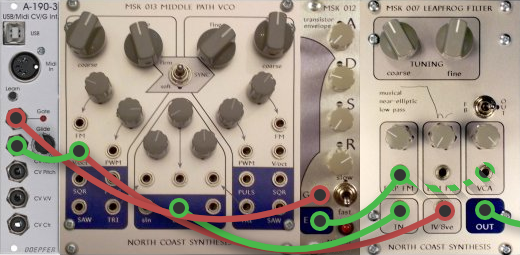
Quadrature outputs on the Middle Path make it a building block for Bode-type frequency shifter patches. In this example, the master (left) oscillator with its PWM knob turned all the way counterclockwise gives two square waves 90° apart in phase on its SQR and PULS outputs. Those drive two of the inputs on the Doepfer dual ring modulator. The master oscillator's contribution to the sine shaper input is turned off. Meanwhile the slave (right) oscillator drives the sine shaper, whose ``sin'' and "cos" outputs also go into the dual ring modulator. A Dual Octave Switch functioning as adder/subtractor gives two different mixes of the ring modulator outputs corresponding to frequency shift up and down. If only one of those were desired, a plain unity mixer would suffice.
Because of the approximations involved in this frequency-shift patch, such as using square waves instead of sines for one of the analytic signals, the result will not be a pure frequency shifted spectrum; some components will shift in the "wrong" direction, or not be filtered out. It'll still sound interesting, though. To get a purer result, patch the sawtooth output of the slave oscillator into the corresponding shaper input, overriding the normalization to the triangle output. Then with the level adjusted to make them as close to pure sine waves as possible, the "sin" and "cos" outputs will be just quadrature sine waves suitable for a pure frequency shift. That same technique can also be used for making the Middle Path a quadrature sine oscillator in a more complicated frequency shifter with external input, a Hilbert transformer, and so on.
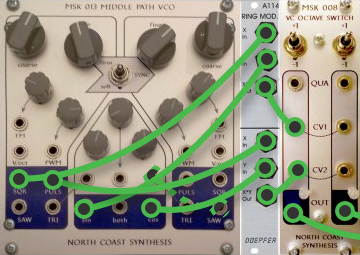
When tuning the Middle Path to match its V/octave reference point to some known value, for instance to match MIDI notes, it's convenient to listen to the beat frequencies in the sine shaper. Here, the Mutable CVpal in "turbocharged monophonic mode" (MIDI channel 2) produces a pitch CV and also a square wave at the corresponding frequency. We patch the pitch CV to the Middle Path V/octave input (affecting both oscillators), the square wave to one of the sine shaper inputs, and then listen to the sine shaper output and play with the shaper levels and oscillator tuning. Bringing up one oscillator at a time against the square wave makes the beat frequency between them strongly audible, at which point it's easy to tune the oscillator to match the MIDI interface within a fraction of a Hz. Other things instead of a CVpal could easily be used as the reference here -- such as other oscillators in a multi-oscillator system.

◀ PREV What's Euclid got to do with it? || Logic, before ICs NEXT ▶
